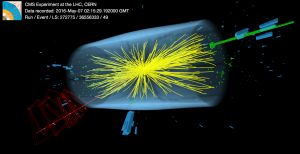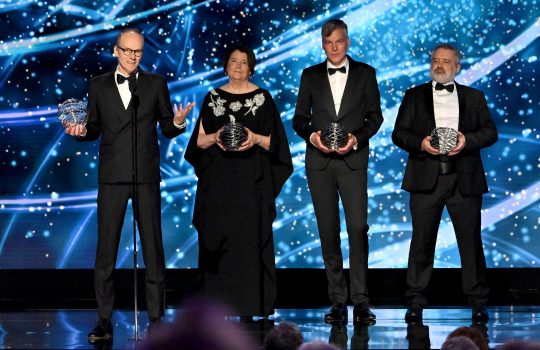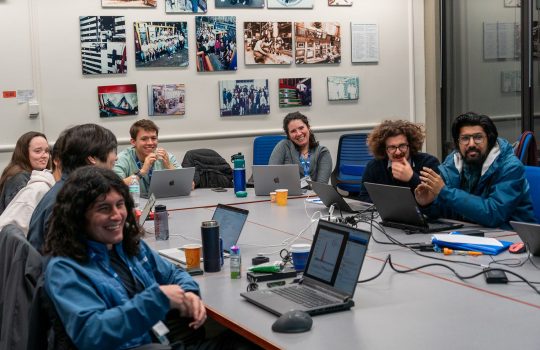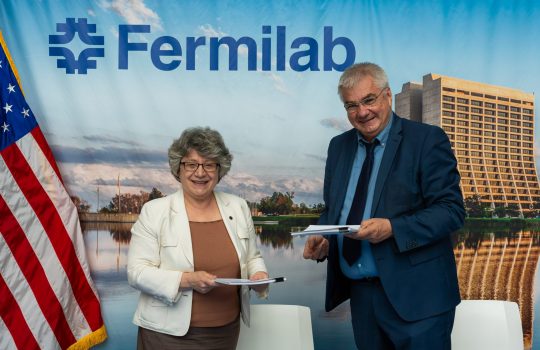Experiments at the LHC are once again recording collisions at extraordinary energies

Collisions recorded on May 7, 2016, by the CMS detector on the Large Hadron Collider. After a winter break, the LHC is now taking data again at extraordinary energies. Image: CERN
Editor’s note: The following news release about the restart of the Large Hadron Collider is being issued by the U.S. Department of Energy’s Fermi National Accelerator Laboratory on behalf of the U.S. scientists working on the LHC. Fermilab serves as the U.S. hub for the CMS experiment at the LHC and the roughly 1,000 U.S. scientists who work on that experiment, including about 100 Fermilab employees. Fermilab is a Tier 1 computing center for LHC data and hosts a Remote Operations Center to process and analyze that data. Read more information about Fermilab’s role in the CMS experiment and the LHC. Fermilab scientists are available for interviews upon request, including Joel Butler, recently elected next spokesperson of the CMS experiment.
After months of winter hibernation, the Large Hadron Collider is once again smashing protons and taking data. The LHC will run around the clock for the next six months and produce roughly 2 quadrillion high-quality proton collisions, six times more than in 2015 and just shy of the total number of collisions recorded during the nearly three years of the collider’s first run.
“2015 was a recommissioning year. 2016 will be a year of full data production during which we will focus on delivering the maximum number of data to the experiments,” said Fabiola Gianotti, CERN director general.
The LHC is the world’s most powerful particle accelerator. Its collisions produce subatomic fireballs of energy, which morph into the fundamental building blocks of matter. The four particle detectors located on the LHC’s ring allow scientists to record and study the properties of these building blocks and look for new fundamental particles and forces.
“We’re proud to support more than a thousand U.S. scientists and engineers who play integral parts in operating the detectors, analyzing the data and developing tools and technologies to upgrade the LHC’s performance in this international endeavor,” said Jim Siegrist, associate director of science for high-energy physics in the U.S. Department of Energy’s Office of Science. “The LHC is the only place in the world where this kind of research can be performed, and we are a fully committed partner on the LHC experiments and the future development of the collider itself.”
Between 2010 and 2013 the LHC produced proton-proton collisions with 8 teraelectronvolts of energy. In the spring of 2015, after a two-year shutdown, LHC operators ramped up the collision energy to 13 TeV. This increase in energy enables scientists to explore a new realm of physics that was previously inaccessible. Run II collisions also produce Higgs bosons — the groundbreaking particle discovered in LHC Run I — 25 percent faster than Run I collisions and increase the chances of finding new massive particles by more than 40 percent.
Almost everything we know about matter is summed up in the Standard Model of particle physics, an elegant map of the subatomic world. During the first run of the LHC, scientists on the ATLAS and CMS experiments discovered the Higgs boson, the cornerstone of the Standard Model that helps explain the origins of mass. The LHCb experiment also discovered never-before-seen five-quark particles, and the ALICE experiment studied the near-perfect liquid that existed immediately after the Big Bang. All these observations are in line with the predictions of the Standard Model.
“So far the Standard Model seems to explain matter, but we know there has to be something beyond the Standard Model,” said Denise Caldwell, director of the Physics Division of the National Science Foundation. “This potential new physics can only be uncovered with more data that will come with the next LHC run.”
For example, the Standard Model contains no explanation of gravity, which is one of the four fundamental forces in the universe. It also does not explain astronomical observations of dark matter, a type of matter that interacts with our visible universe only through gravity, nor does it explain why matter prevailed over antimatter during the formation of the early universe. The small mass of the Higgs boson also suggests that matter is fundamentally unstable.
The new LHC data will help scientists verify the Standard Model’s predictions and push beyond its boundaries. Many predicted and theoretical subatomic processes are so rare that scientists need billions of collisions to find just a small handful of events that are clean and scientifically interesting. Scientists also need an enormous amount of data to precisely measure well-known Standard Model processes. Any significant deviations from the Standard Model’s predictions could be the first step towards new physics.
The United States is the largest national contributor to both the ATLAS and CMS experiments, with 45 U.S. universities and laboratories working on ATLAS and 49 working on CMS.
CERN, the European Organization for Nuclear Research, is the world’s leading laboratory for particle physics. It has its headquarters in Geneva. At present, its member states are Austria, Belgium, Bulgaria, the Czech Republic, Denmark, Finland, France, Germany, Greece, Hungary, Israel, Italy, the Netherlands, Norway, Poland, Portugal, Slovakia, Spain, Sweden, Switzerland and the United Kingdom. Romania is a candidate for accession. Cyprus and Serbia are associate members in the pre-stage to membership. Turkey and Pakistan are associate members. India, Japan, the Russian Federation, the United States of America, Turkey, the European Union, JINR and UNESCO have observer status.
Fermilab is America’s premier national laboratory for particle physics and accelerator research. A U.S. Department of Energy Office of Science laboratory, Fermilab is located near Chicago, Illinois, and operated under contract by the Fermi Research Alliance LLC. Visit Fermilab’s website at www.fnal.gov and follow us on Twitter at @Fermilab.
The DOE Office of Science is the single largest supporter of basic research in the physical sciences in the United States and is working to address some of the most pressing challenges of our time. For more information, please visit science.energy.gov.
The National Science Foundation (NSF) is an independent federal agency that supports fundamental research and education across all fields of science and engineering. In fiscal year (FY) 2015, its budget is $7.3 billion. NSF funds reach all 50 states through grants to nearly 2,000 colleges, universities and other institutions. Each year, NSF receives about 48,000 competitive proposals for funding and makes about 11,000 new funding awards. NSF also awards about $626 million in professional and service contracts yearly.



